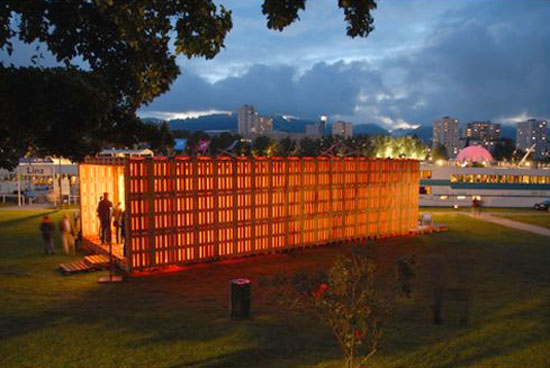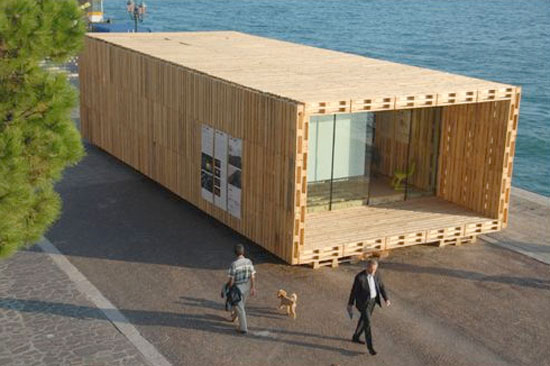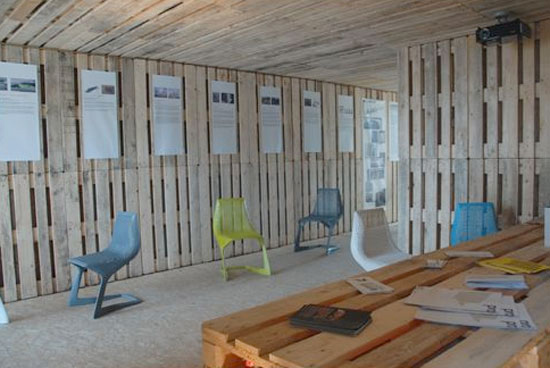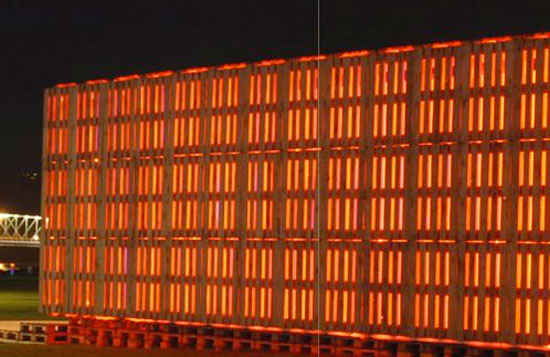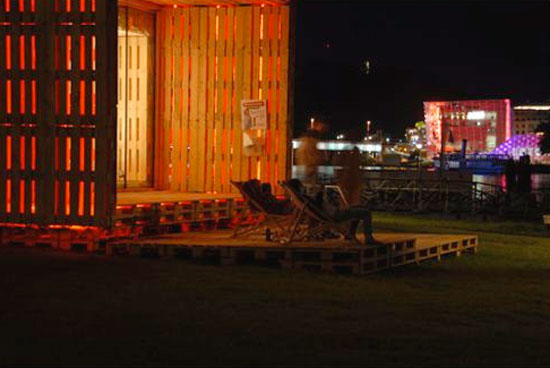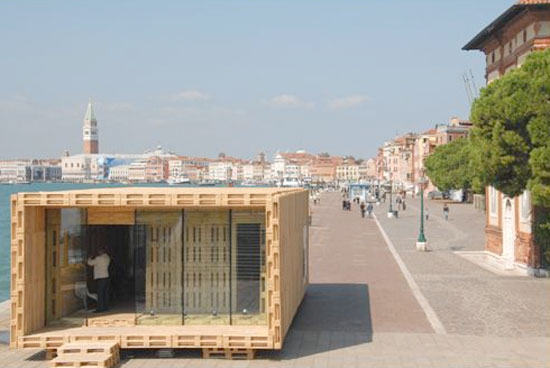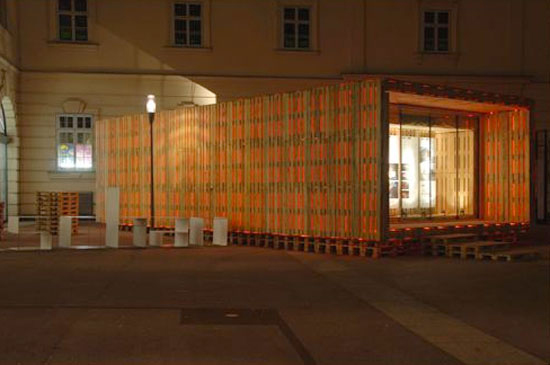Schnetzer Andreas Claus and Pils Gregor, two University of Vienna students, are the brains behind Pallet House, a recycled wood pallets home design that is no frills, all function. This sustainable, recycled house uses pallets to form a modular structure design that’s as efficient environmentally as it is economically.This home takes a simple cube shape, complete with an outdoor entertaining area and sliding glass walls opening onto the open-concept interior. From the outside, the recycled enclosure glows by the light from within. The eco sustainable wood home was originally conceived as part of a 2008 competition (which it took first place in) and has since been displayed at several major European cities, now appearing in South Africa. Schnetzer Andreas Claus and Pils Gregor
Wednesday, July 27, 2011
Thursday, July 21, 2011
9 Terms for Your Eco-Friendly Vocabulary
EcoBroker.This real estate certification program helps practitioners become experts in helping consumers and communities use energy efficiency and sustainable design. Through EcoBroker educational courses, you acquire knowledge and resources to become a Certified EcoBroker, which gives you a leg up in assisting home owners in purchasing and marketing properties with green features. Classes are available online, and may count as continuing education credits in your state.
FSC-certified wood. A key component of green building is using sustainable wood. Quickly renewable woods like bamboo are inherently sustainable. In selecting other types of hardwoods, it’s important that the wood be grown and harvested in a sustainable manner. The Forest Stewardship Council (FSC) maintains standards and certifies woods for sustainability.
Geothermal. Geothermal power uses heat from the earth to generate electricity. This is a clean, renewable power source. Geothermal energy is harnessed with a Ground Source Heat Pump (GSHP) to tap the stored energy beneath the planet’s surface. These pumps can be used to provide heating, cooling, and hot water for residential and commercial buildings.
LEED. LEED is an abbreviation for Leadership in Energy and Environmental Design. The LEED rating system was designed by the U.S. Green Building Council and is the standard for the design, construction, and operation of green buildings. LEED started in the commercial building sector, and a rating system for residential construction is in the works. Architects and builders often refer to themselves as LEED AP; the AP stands for Accredited Professional. This means they have passed the LEED exam and are well-versed in the program’s standards.
Native landscaping.Selecting plants indigenous to your area means they’re better adapted to the local climate, use appropriate amounts of water, resist local pests, and provide food for area wildlife.
Runoff.The waste water that flows from our gardens, lawns, driveways, and streets into our sewer systems carries various pollutants, including fertilizers and pesticides from our yards. The water eventually travels into rivers and oceans where they degrade water quality for humans and animals. To reduce runoff, home owners can make sure they don’t over-water their lawns or accidentally water their sidewalks and driveways. Permeable stone pavers in driveways also help curb runoff.
Solar PV/ Solar Water Heaters. Solar PV stands for Solar Photovoltaic, which are the panels used to create electricity. PV cells are comprised of semi-conductors, most often made of silicon, which convert sun power into electricity. These are different from (and more expensive than) solar water-heating systems. A solar water-heating system is fairly simple with the solar panels typically installed on a roof. The sun then heats the panels; the solar collectors heat a fluid in pipes held in the interior of the panel boxes, and the fluid is transported into the house where it heats water in a storage tank.
Sustainable/Sustainability. Sustainability refers to meeting present needs without compromising the ability of future generations to meet their needs. This involves using, re-using, and conserving natural resources to do the least harm to the natural environment. It’s now used almost interchangeably with “green” and “eco-friendly.”
VOC. An abbreviation for Volatile Organic Compounds, VOCs are emitted as gases from various solids and liquids like wall paint, furniture, and household cleaning supplies. Many chemicals are harmful to human health; some are carcinogenic. But no- or low-VOC products now available represent good non-toxic replacements.
FSC-certified wood. A key component of green building is using sustainable wood. Quickly renewable woods like bamboo are inherently sustainable. In selecting other types of hardwoods, it’s important that the wood be grown and harvested in a sustainable manner. The Forest Stewardship Council (FSC) maintains standards and certifies woods for sustainability.
Geothermal. Geothermal power uses heat from the earth to generate electricity. This is a clean, renewable power source. Geothermal energy is harnessed with a Ground Source Heat Pump (GSHP) to tap the stored energy beneath the planet’s surface. These pumps can be used to provide heating, cooling, and hot water for residential and commercial buildings.
LEED. LEED is an abbreviation for Leadership in Energy and Environmental Design. The LEED rating system was designed by the U.S. Green Building Council and is the standard for the design, construction, and operation of green buildings. LEED started in the commercial building sector, and a rating system for residential construction is in the works. Architects and builders often refer to themselves as LEED AP; the AP stands for Accredited Professional. This means they have passed the LEED exam and are well-versed in the program’s standards.
Native landscaping.Selecting plants indigenous to your area means they’re better adapted to the local climate, use appropriate amounts of water, resist local pests, and provide food for area wildlife.
Runoff.The waste water that flows from our gardens, lawns, driveways, and streets into our sewer systems carries various pollutants, including fertilizers and pesticides from our yards. The water eventually travels into rivers and oceans where they degrade water quality for humans and animals. To reduce runoff, home owners can make sure they don’t over-water their lawns or accidentally water their sidewalks and driveways. Permeable stone pavers in driveways also help curb runoff.
Solar PV/ Solar Water Heaters. Solar PV stands for Solar Photovoltaic, which are the panels used to create electricity. PV cells are comprised of semi-conductors, most often made of silicon, which convert sun power into electricity. These are different from (and more expensive than) solar water-heating systems. A solar water-heating system is fairly simple with the solar panels typically installed on a roof. The sun then heats the panels; the solar collectors heat a fluid in pipes held in the interior of the panel boxes, and the fluid is transported into the house where it heats water in a storage tank.
Sustainable/Sustainability. Sustainability refers to meeting present needs without compromising the ability of future generations to meet their needs. This involves using, re-using, and conserving natural resources to do the least harm to the natural environment. It’s now used almost interchangeably with “green” and “eco-friendly.”
VOC. An abbreviation for Volatile Organic Compounds, VOCs are emitted as gases from various solids and liquids like wall paint, furniture, and household cleaning supplies. Many chemicals are harmful to human health; some are carcinogenic. But no- or low-VOC products now available represent good non-toxic replacements.
Wednesday, July 20, 2011
Eco-Friendly Building Trends to Follow
Copper Roofs. Copper roofs and their alloys can last 100+ years and are recyclable.
Timber Framing. Timber framing, which generally includes the use of SIPS (superior insulating panels), uses less lumber and generates less waste.
Low-E Windows. Low-emittance windows block UV rays from entering a house, which heat its interior and fades its decorative contents.
Rainwater Holding Tanks. Rainwater runoff, captured in holding tanks via roofs and gutters, can feed a sprinkler system or may be filtered for indoor plumbing use.
LED Lighting. Light emitting diodes provide chemical free lighting and use 80% less energy than a standard incandescent bulb.
Green Toilets. Good for the environment and your budget, water-conserving toilets use 20 % less water per flush and can save 30 to 50% on your annual water bill.
Solar Orientation. Orientating new construction in the proper direction can curtail the amount of heat and cold that enters a home, thus reducing heating and cooling costs and energy consumption.
Induction Cook Tops. Coils of an induction cook top emit heat directly into the bottom of cookware, which results in less energy wasted in the cooking process.
Geothermal Heating and Cooling. Using the earth as a heat exchanger can cost twice as much as a traditional heating and cooling system in initial installation, but can also pay for itself in as little as five years.
Attic Heat Blocker. High-tech heat blockers made of aluminum foil that has been laminated onto oriented strand board, can reduce an attic’s temperature by 30 degrees, which translates into reduced energy consumption and costs.
Reclaimed Wood Counter Tops. Fast-growing plants such as bamboo as well as reclaimed wood are gaining popularity and new life as chic counter tops.
Nontoxic Paint. Shunning VOC’s (Volatile Organic Components), a turn to nontoxic paint keeps indoor air clean and keeps pollutants out of landfills.
Formaldehyde-free Insulation. Many building products, such as insulation, release chemicals with which they are made thus effecting indoor air quality.
Smart Irrigation Systems. Smart sprinkler systems are controlled via satellite that sends current weather conditions to the system’s ‘brain’, eliminating needless watering.
Green Furniture. Salvaged wood from structures slated for tear down is spared a trip to a landfill and is becoming material for furniture, extending its life and usefulness.
Tuesday, July 19, 2011
Green Building Projects in India
Accepted definitions of green buildings describe them as structures that ensure efficient use of materials, water, energy and other resources without depletion of nature and minimal generation of non-degradable waste. The concept of green buildings was prevalent in India from the time of our ancestors who revered the five elements of nature. Today, India can boast of Leadership in Energy & Environmental Design (LEED)-certified green buildings ranging from residential complexes, exhibition centers, hospitals, and educational institutions to laboratories, IT parks, airports, government buildings and corporate offices. This list of top 10 green buildings in India gives special mention to those extraordinary structures that have left an indelible mark in the green construction industry.
Suzlon Energy Limited - Pune
Several accolades continue to shower upon Suzlon’s global headquarter in Pune - “One Earth” - ever since the facility has been LEED ‘Platinum’ rated and certified as an eco-friendly building by the Green Building Council. Built to perfection on an area of 41,000 square meters (10.13 acres), One Earth can be counted as among the largest green building projects in India and is living proof that our world can be replenished with a little green effort, everyday.
Several accolades continue to shower upon Suzlon’s global headquarter in Pune - “One Earth” - ever since the facility has been LEED ‘Platinum’ rated and certified as an eco-friendly building by the Green Building Council. Built to perfection on an area of 41,000 square meters (10.13 acres), One Earth can be counted as among the largest green building projects in India and is living proof that our world can be replenished with a little green effort, everyday.

Biodiversity Conservation India Ltd (BCIL) - Bangalore
As a green builder who strives for the conservation of diversity in vegetation, forests, culture and urban lifestyles, BCIL has created some of the most energy-efficient residential homes India has ever set eyes upon. The company’s TZed homes in Whitefield, Bangalore has been certified as the first residential apartment in the world to be rated ‘Platinum’ under LEED. TZed, which means “Towards Zero Energy Development” is a 2,49,000 sq.ft. green project spread across 5.5 acres and is designed to reduce lighting and energy by nearly 70 per cent.
As a green builder who strives for the conservation of diversity in vegetation, forests, culture and urban lifestyles, BCIL has created some of the most energy-efficient residential homes India has ever set eyes upon. The company’s TZed homes in Whitefield, Bangalore has been certified as the first residential apartment in the world to be rated ‘Platinum’ under LEED. TZed, which means “Towards Zero Energy Development” is a 2,49,000 sq.ft. green project spread across 5.5 acres and is designed to reduce lighting and energy by nearly 70 per cent.

Olympia Technology Park - Chennai
The world’s largest LEED ‘Gold’ rated green building is right here in India. Built on an area of 1.8 million sq. ft., this futuristic masterpiece features three mighty towers on 8.4 acre greenery. Constructed with energy saving technology, autoclaved blocks containing 30 per cent flyash, wooden door-frames made from compressed sawdust and low VOC (Volatile Organic Compounds) paints, Olympia is green and eco-friendly in every sense of the word.
The world’s largest LEED ‘Gold’ rated green building is right here in India. Built on an area of 1.8 million sq. ft., this futuristic masterpiece features three mighty towers on 8.4 acre greenery. Constructed with energy saving technology, autoclaved blocks containing 30 per cent flyash, wooden door-frames made from compressed sawdust and low VOC (Volatile Organic Compounds) paints, Olympia is green and eco-friendly in every sense of the word.

ITC Green Centre - Gurgaon
Renowned as one of the early adopters of the green building movement in India, the ITC Green Centre is still considered a benchmark for green buildings. It was the first 'Platinum' rated building in India and has endeavored to adopt green practices that go beyond recycled waste and day-lit offices. Within a built-in area of 180,000 sq.ft., the building features alternative transportation facilities, storm water management system, solar thermal technology, reflective high-albedo roof paint, minimal exterior lighting, separate smoking rooms with exhaust system and zero-water discharge.
Renowned as one of the early adopters of the green building movement in India, the ITC Green Centre is still considered a benchmark for green buildings. It was the first 'Platinum' rated building in India and has endeavored to adopt green practices that go beyond recycled waste and day-lit offices. Within a built-in area of 180,000 sq.ft., the building features alternative transportation facilities, storm water management system, solar thermal technology, reflective high-albedo roof paint, minimal exterior lighting, separate smoking rooms with exhaust system and zero-water discharge.

The Druk White Lotus School - Ladakh
In this desert landscape of severe climatic conditions, 3,500 meters above sea level, was born a modest school that is adjudged as an outstanding example of sustainable, green, cost effective building development. This multi-award winning structure is the recipient of the Best Asian Building, Best Education Building and Best Green Building awards. It combines the best of traditional Ladakhi architecture with 21st century engineering excellence and is built with traditional materials such as locally excavated stone, mud bricks, timber and grass.
In this desert landscape of severe climatic conditions, 3,500 meters above sea level, was born a modest school that is adjudged as an outstanding example of sustainable, green, cost effective building development. This multi-award winning structure is the recipient of the Best Asian Building, Best Education Building and Best Green Building awards. It combines the best of traditional Ladakhi architecture with 21st century engineering excellence and is built with traditional materials such as locally excavated stone, mud bricks, timber and grass.

La Cuisine Solaire - Auroville
One of the most innovative green buildings in the country is the solar kitchen at Auroville that best demonstrates the use of solar energy to produce steam. This 1700 sq. m. kitchen is named thus because of the huge 15 diameter solar bowl that has been fixed at the top of the structure to harvest solar energy. On a clear day, this green structure can generate enough steam at a temperature of 150°C that can be used to cook meals for 1000 people, three times a day.
One of the most innovative green buildings in the country is the solar kitchen at Auroville that best demonstrates the use of solar energy to produce steam. This 1700 sq. m. kitchen is named thus because of the huge 15 diameter solar bowl that has been fixed at the top of the structure to harvest solar energy. On a clear day, this green structure can generate enough steam at a temperature of 150°C that can be used to cook meals for 1000 people, three times a day.

Doon School - Dehradun
Authorities can rightfully claim that this establishment is one of India's first green school campuses that opted for recycling measures and successfully achieved cent per cent self-sufficiency in energy, water and organic fertilizer. Several old building blocks that were part of the 69 acre school were redesigned and solar thermal systems, waste management processes as well as biomass gasification systems were introduced as part of its green initiatives.
Authorities can rightfully claim that this establishment is one of India's first green school campuses that opted for recycling measures and successfully achieved cent per cent self-sufficiency in energy, water and organic fertilizer. Several old building blocks that were part of the 69 acre school were redesigned and solar thermal systems, waste management processes as well as biomass gasification systems were introduced as part of its green initiatives.

Raintree Hotels - Chennai
Here is an eco-sensitive hotel for the eco-savvy traveler. The entire chain of Raintree business hotels across Chennai city are the first eco-sensitive hotels in South India. Everything about this hospitality range is green: right from the rubber wood, bamboo and medium-density fiber used for construction down to the Portland Pozzalana cement containing 15 to 20 per cent fly ash. The George Fisher concealed cistern installed at the hotel controls the water used in toilet flushes and the sewage treatment plant recycles water for use in air conditioners.
Here is an eco-sensitive hotel for the eco-savvy traveler. The entire chain of Raintree business hotels across Chennai city are the first eco-sensitive hotels in South India. Everything about this hospitality range is green: right from the rubber wood, bamboo and medium-density fiber used for construction down to the Portland Pozzalana cement containing 15 to 20 per cent fly ash. The George Fisher concealed cistern installed at the hotel controls the water used in toilet flushes and the sewage treatment plant recycles water for use in air conditioners.

Rajiv Gandhi International Airport - Hyderabad
India’s first Greenfield airport is undeniably among the top 10 green buildings in India and the first airport in Asia to be awarded the LEED ‘Silver’ rating certification by US Green Building Council. Featuring 100,005 sq. m. of glass encased terminal, this green building ensures optimal use of natural light and minimal wastage of electricity or energy consumption. Yet another of its green features includes the recycling of treated wastewater for landscaping, air conditioning and flushing requirements.
India’s first Greenfield airport is undeniably among the top 10 green buildings in India and the first airport in Asia to be awarded the LEED ‘Silver’ rating certification by US Green Building Council. Featuring 100,005 sq. m. of glass encased terminal, this green building ensures optimal use of natural light and minimal wastage of electricity or energy consumption. Yet another of its green features includes the recycling of treated wastewater for landscaping, air conditioning and flushing requirements.

Nokia - Gurgaon
Among India’s most sustainable buildings is the corporate office of Nokia in Gurgaon which has been granted accreditation as one of the world’s leading green buildings by the U.S. Green Building Council (USGBC). This is the first time that a commercial interior fit-out project in India is being awarded the Green Building Award and prestigious LEED ‘Gold’ rating. What makes this green office stand out from the rest is its smart lighting and ventilation systems, high-efficiency chillers, high-performance double glazing, heat recovery wheel, green guard certified furniture and online CO2 monitoring system.
Among India’s most sustainable buildings is the corporate office of Nokia in Gurgaon which has been granted accreditation as one of the world’s leading green buildings by the U.S. Green Building Council (USGBC). This is the first time that a commercial interior fit-out project in India is being awarded the Green Building Award and prestigious LEED ‘Gold’ rating. What makes this green office stand out from the rest is its smart lighting and ventilation systems, high-efficiency chillers, high-performance double glazing, heat recovery wheel, green guard certified furniture and online CO2 monitoring system.

Monday, July 18, 2011
Testing the Energy Efficiency of Your Home
Once all the insulation has been installed and air sealing is completed, the building needs to be tested to make sure that it performs as designed. This step typically identifies areas where insulation has been missed, air sealing is insufficient, or mechanical systems are not functioning up to specs. A zero energy house scores 0 or below on the home energy rating system (HERS) scale. Most near zero energy homes get below HERS 20, which is excellent given that a conventional home built to code has a HERS score of 100.
Testing for remodels and new construction is similar, with one exception. For a zero energy retrofit of an existing building, the place to start is with a computerized analysis of utility bills, which can help separate out the energy used for heating, cooling, water heating, and miscellaneous electrical loads. It is important to have the house tested before construction starts and then again when the home is finished.
Blower Door Test
A blower door test puts the house under negative pressure to determine its relative airtightness and to locate specific points of air leakage. The blower door is a fan that exhausts air to a specific pressure inside, typically 50 pascals, the equivalent of 10 mph to 15 mph wind speed. The fan is positioned in an expandable frame that is sealed into an open door jamb. Used in conjunction with a smoke stick test, the blower-door test allows you to actually see when air is leaking. The test is best perform the dry wall is hung so remediation can take place where the air leakage is discovered. This is a critical step for zero energy homes. Conventional homes with high-powered HVAC equipment can get away with some air leakage. When a home is primarily heated with solar and equipment waste heat, airtightness becomes crucial.
Energy Audit - Insulation Check
An energy audit is another important step in evaluating a home's weak spots. An audit covers many things, including inspection of the attic, basement or crawl space, and walls to evaluate the quality of the insulation. This step, along with the Blower Door Test and the Infrared Camera Scan help ensure that the thermal barrier is intact.
Healing, Cooling and Hot-Water Heating Appliances Assessment
The water heater, furnace or boiler, and air-conditioner should all be inspected for efficiency. Testing the ducts with a duct blast, if applicable, determines the integrity of the duct connections. Many auditors are also able to perform a worst-case combustion air zone test to determine if appliances are venting properly (such as when all of the exhaust fans in the home are operating at the same time) to prevent back-drafting of carbon monoxide down flues. This test also identifies whether the HRV or ERV is functioning properly.
Duct Blaster Test
A duct blaster test uses a device that pressurizes the ductwork and determines air leakage through pressure loss. If you are using ductwork for conditioned air, it needs to be airtight. EnergyStar requires less than 6% air leakage, which is a tough but obtainable standard. All joints in ductwork must be sealed with mastic to eliminate air leakage, and panned ducts should never be considered. (A panned duct is one in which a piece of sheet metal is screwed to the bottom of a joist to reduce sheet metal work.) Panned ducts trap moisture in the joist space and are always leaky. When you are dealing with subtle air flows in a zero energy home, it is critical to have air movement only where and when you want it. Air losses with heat-recovery ventilation can reduce the efficiency of the equipment.
Windows and Doors
An audit should also include an inspection of the windows and doors in a home, both for airtightness and energy efficiency. On occasion, the expanding foam between the rough opening and the window can bind the frame so that it doesn't open and close appropriately. Doors may have to be adjusted at the hinges to make sure they seal properly. This is where the smoke stick test comes in handy.
Lighting and Large Appliance Evaluation
An energy auditor will assess the efficiency of the lighting system, refrigerator, washing machine, freezer, and other appliances. Each appliance should be plugged into a watt meter to determine and record how much power is required to run it. The results will affect the size of the photovoltaic array required to meet the total load.
Infrared Camera Scan
Infrared Cameras (IRCs) allow you to look through walls and ceilings to check for missing insulation and locate air leaks. The IRC scan is best conducted when there is a temperature difference between inside and outside of at least 20°F. The greater the temperature differential, the more dramatic the photos.
Wednesday, July 13, 2011
Antwerp Water Tower Transformed Into Translucent 6-Story Apartment
A historic water tower in Antwerp received a major redo when it was transformed from a utilitarian city owned property into a modern and glowing 6-story apartment building. The tower's renovation was designed and led by Jo Crepain, an award winning Belgian architect who unfortunately died in 2008 from cancer. The water tower apartment, called Woning Moereels, stands as a legacy of his work revealing that simplicity in design can sometimes lead to the most elegant of solutions.
The water tower stood empty for many years before the city decided to sell it. A local landscape architect jumped at the chance to make it into his dream home. Working with Jo Crepain, the two created a simple plan to create a 6-story apartment with a winter garden set below the old concrete water tower. The home is set on six meter high living space with a 4-story tower enclosed with translucent glass panels. Views from the home overlook the adjacent Braaschaat forest and a steep staircase leads up to each floor.
Fluorescent lighting facing the street gives the tower a glowing appearance at night as thought it were a lighthouse for the town. The glass walls encourage plenty of natural daylighting, but are not transparent enough for passersby to see what is going on inside. The old concrete tower and the new glass facade “reinforces the ambition of an industrial symbiosis between old and new.” Woning Moereels is an intriguing adaptive reuse project that enhances the original industrial qualities of the water tower while creating a new and useful space.
Crepain and his client had to work on a small budget to make the project work and as the architect said back in 2008, “We were lucky we didn’t have the money, because what we have now is a simple, sober, beautiful building. Sometimes it’s hard to do something simple, harder than doing something complicated. We have to keep in mind Ludwig Mies van der Rohe and his “less is more” and “work hard to do less.”
Tuesday, July 12, 2011
7 Ancient Wonders of Green Design & Technology
We have come a long way since humans first used biomass fuels for their fires over 800,000 years ago. Green design, sustainable innovation, alternative energy – these are all recently-coined buzz-phrases for concepts that in some cases date back tens of thousands of years. The ancient Chinese used concentrated solar power for heat energy and fire, Native Americans used hot springs as renewable geothermal sources for cooking and healing, and some speculate the Egyptians used wind power to help build their pyramids. From Greece and Rome to Persia and North America, here are seven incredibly innovative uses of geothermal, water, wind and solar power from around the ancient world.
Ancient Wind Power Designs
1) Wind for Power and Water: Ancient Persian Windmills
Persia is also the original home of one of the most complex passive ventilation and cooling systems that has ever existed – 2,000-year-old engineering that rival modern hi-tech equivalents with the simple and elegant effectiveness of their design. Using a combination of air pressure differentials, structural orientation and running water these windcatcher structures help regulate temperatures in the harshest of desert environments with cool nights and burning hot days.
Ancient Water Power Designs
3) Water Power: Ancient Roman Gravity AqueductsThe Romans are well known for their many colossal and ingenious works of architecture and engineering but perhaps most of all for their gravity-driven water-distributing and waste-evacuating aqueducts – some of which are still in use today. More than a marvel of ancient plumbing, these aqueducts are also an early example of renewable water power for mines, forges, mills and baths. Water was used in hydraulic mining to prospect for, crush and wash ore and likely to operate hammers to crush ore and water wheels.
4) Water Reuse: Ancient Jerusalem Gray-Water Plumbing
Located at high elevation and away from plentiful sources of surface water, the ancient city of Jerusalem has relied on underground rivers and other difficult-to-access subterranean sources of water for nearly 15,000 years and still has well tunnels that date back to the 12th Century BC. As the city grew and evolved so did its water use and reuse systems. Sink water was conserved in basins and used to flush waste much like modern sewers but also saved to water gardens while particulates were filtered to provide fertilizer for surrounding fields.
Ancient Geothermal Power Design
5) Renewable Geothermal Heat Energy: Ancient Roman Thermal BathsAncient Romans used geothermal energy indirectly through the water it heated, particularly in cities like the infamous volcano-buried Pompeii (shown above) for their baths and to heat homes. These thermal energy projects were invariably limited by location and dependent on proximity to places like the area around Mount Vesuvius where hot magma was closer to the Earth’s surface. Romans also created ice using thermal differentials – carving pits, putting in water and covering them during the day so they would freeze at night.
Ancient Solar Power Designs
6) Passive Solar Orientation for Heating: Ancient Greek Cities
7) Passive Solar Shade for Cooling: Native American Cliff Dwellings
The so-called Cliff Palace in Mesa Verde National Park, Colorado is the largest cliff dwelling of its kind in North America. The people who once lived there had lives that revolved around the sun in more ways than one. The passive solar (and other weather) protection provided by the monstrous overhanging cliff above the settlement is just one example. They also build structures in key positions to be solar indicators at particular times of the year, including solstices, for pragmatic and religious purposes.
Straw Bale Construction
People have built homes using straw, grass, or reed throughout history. During the late 1800s on the American plains however, straw bales houses were a matter of necessity; there was no lumber for construction. Now, with the rise in interest in sustainable housing, there's been a revival in straw bale construction. It's mostly been in the U.S., but in 1995, Bob Matthews, of the Institute for Social Inventions and author of The Complete Manual of Practical Home Building, built a straw cabin in the U.K. (possibly the first such building in Britain) and has been living in it ever since.
With straw often being a farm surplus product and very cheap (around 40p a bale, or £1.50 delivered), it's inexpensive, and an easily renewable medium. Properly built, straw bale houses are fire-resistant, waterproof and actually pest free, with super-insulated walls.
Construction Basics
You'll need about 300 standard three-wire bales of straw to make a 2,000 square-foot house (186 sq. metres). You skewer them on rebar pins (or wood or bamboo stakes) to keep them firm. When you've finished, after adding plumbing and wiring, you seal and finish the walls.You need to use bales that have a uniform size (about a metre long, half a metre wide), are well secured with two strings, and with very few seed heads. Make sure they're compacted properly and dense - each bale should weight between 16-30 kilos - and dry (and be sure you keep them dry when you're building, for obvious reasons). Even after you've finished the house, you need to be certain the centre of the bales doesn't become wet through either the top or bottom - however, if the outside gets wet, that's fine; it'll dry out naturally.
Types of Construction
Use a "non-structural" or "in-fill" system for bigger structures. That means you make a frame first to support the roof, then pierce the bales with rebar as you rise, attaching the bales to the frame to keep your walls secure."Structural bale construction" is a little like Lego, where you stack the bales together in a "running bond" manner. After construction, you simply stucco the exterior and plaster the interior walls. However, since the bales compress as they settle, you need to leave settlement gaps above both windows and doors (how much depends on the number of bales).
Straw and clay construction is a little like cob. You mix clay and water, and then add straw, before packing it into a wooden frame.
Mortar bale construction is similar to working with giant bricks. You put mortar between the bales, and the mortar actually takes the wall's weight (it needs to be quite thick - at least an inch on all surfaces of the bale). It's a good method when you're making a two storey house or a basement. About the only drawback is that the mortar creates cold bridges and thermal leaks. Again, use stucco and plaster to add to the structural integrity.
Finally, there are also pressed straw panels. Here you use straw that's been compacted under pressure. You can also use the panels for floors and roofs if you wish.
Maintenance
In theory, at least, a properly constructed straw house, built where there's good drainage, could last for centuries. You should probably use a different material for the roof, however (something more permanent), and build that roof at a steep angle for drainage.Foundation
If you're building a straw bale house in Britain, the climate means you'll have to be on a self-draining foundation (one of the best is a rubble trench). You'll also need plastic or metal strapping to attach the wallplate (use anchor bolts) to the foundation.Make sure your foundation goes well below the frost line, and then fill it with small stones before you put concrete in the rest of the space. You also have to be sure that water can't gather at the point where the bales meet the foundation, which means you need to elevate the foundation by at least 23mm (much higher is better), and leave a good overhang (around 450mm) on the roof.
Finishes
Obviously, after you've completed the construction, you still need to render, or finish, the place. Limewash is good, but very expensive. Earth plaster is an American favourite and durable to use both inside and outside. It's non-toxic, and comes in many colours. Additionally, you have plenty of time to work it and it dries to a hard surface.Rot and Pests
You shouldn't have a problem with rot as long as you use dry bales. Remember, though, that all the paint must be permeable so moisture isn't trapped in the wall. Believe it or not, you find fewer insects or vermin in straw bales than you do in wood, and once you've plastered the building, they can't get in.Fire
You might also be surprised to learn that straw bale construction is very fire-resistant; in tests it actually out-performed conventional building materials. However, in spite of all its advantages, getting a mortgage for a straw bale house can be difficult as can insuring it.
Subscribe to:
Posts (Atom)
